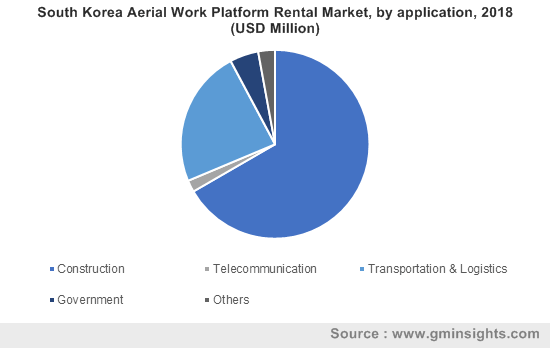Home > Pressrelease > South Korea AWP Rental Market size worth $350mn by 2025
South Korea AWP Rental Market size worth $350mn by 2025
- Published Date: May 8, 2019
South Korea Aerial Work Platform (AWP) Rental Market size is set to exceed USD 350 million by 2025; according to a new research report by Global Market Insights Inc.
The increasing government investments for infrastructure refurbishment, growth in the construction sector, and the rapid urbanization & industrialization will propel the South Korea AWP rental market. Urbanization has increased the pressure of building high-rise structures that can hold a great number of people in a smaller space, supporting the AWP rental market growth in South Korea. Several other infrastructure facilities, such as ports, airports, rail networks, and official facilities, are gaining investments in South Korea, which will add up to the demand for various machines. Additionally, the rise in the number of workplace fatalities due to the use of traditional construction equipment that lacks advanced features has compelled the government to stress on several regulations pertaining to the safety of operators.
The vertical mast lifts segment in the South Korea AWP rental market, is set to grow at a rapid rate owing to various advantages offered in construction works. Vertical mast lifts are mostly battery-powered, enabling a clean working of machines. Enhanced maneuverability and ease of operations are the two major factors driving the vertical mast lifts market growth. The spacious platform enables the lifting of a person along with the required equipment. The lightweight & compact structure of vertical mast lifts makes them a feasible option for applications such as indoor lighting work, installation works, and electrical & mechanical works. The increasing demand for electric-based and low-emission equipment in the country due to high user awareness is compelling companies to enhance their rental fleet. Machinery providers in the South Korea AWP rental market are deploying vertical mast lifts in huge numbers to address the growing industry demand. For instance, in December 2017, AJ Networks acquired 396 vertical mast lifts from Haulotte Group to support the rising demand from domestic customers, which are used in various construction & maintenance projects in Samsung, SK Hynix, etc.

Get more details on this report - Request Free Sample PDF
Browse key industry insights spread across 94 pages with 63 market data tables & 16 figures & charts from the report, “South Korea Aerial Work Platform (AWP) Rental Market Size By Product (Boom Lift, Scissor Lift, Vertical Mast Lift, Personal Portable Lift), By Application (Construction, Telecommunication, Transportation & Logistics, Government), Growth Potential, Competitive Market Share & Forecast, 2019 - 2025” in detail along with the table of contents:
https://www.gminsights.com/industry-analysis/south-korea-aerial-work-platform-awp-rental-market
In the South Korea AWP rental market, the demand for AWPs from the telecommunication industry was valued at over USD 6 million and is expected to rise in the coming years. Various government initiatives are refurbishing the current telecom infrastructure and building sophisticated telecom network using advanced technologies to boost the demand for AWPs. The sturdy structure of AWPs and the availability of a variety of designs make them a convenient option as compared to other conventional machines & human labor. The increasing penetration of telecom companies and their efforts to expand the network will further boost the demand for AWPs. For instance, in February 2019, Huawei partnered with LG Uplus to complete the Seoul TechCity project, which is a part of the company’s smart city development strategy. The increasing number of smartphones and the need for improved connectivity provided by enhanced infrastructure are expected to boost the AWP rental market development in South Korea.
The companies in the South Korea AWP rental market are AJ Networks Korea Rental Corporation, Prince Lift, YK Construction Equipment, etc. Other companies that operate in the region are manufacturers that provide a variety of lifts such as scissor, boom, and personal portable machines. These manufacturers include JLG, Skyjack, Genie, etc., which gain orders in huge quantities from rental providers. Both the entities operating in the South Korea AWP rental market develop strong relationships for carrying out further orders. The rental providers are focusing on maintenance of their machinery fleet and include products depending on customers’ demand. The growing investments for purchasing new machines is driving the AWP rental market in South Korea, which will increase the fleet size and availability.
The South Korea AWP rental market research report includes in-depth coverage of the industry with estimates & forecast in terms of revenue in USD and fleet size in units from 2015 to 2025, for the following segments:
South Korea AWP Rental Market, By Product
- Boom lift,
- Scissor lift
- Vertical mast lift
- Personal portable lift
South Korean AWP Rental Market, By Application
- Construction
- Telecommunication
- Transportation & Logistics
- Government